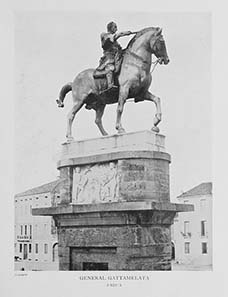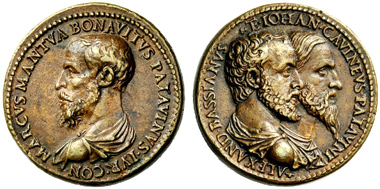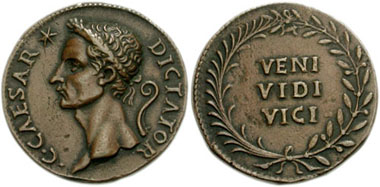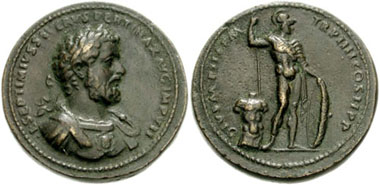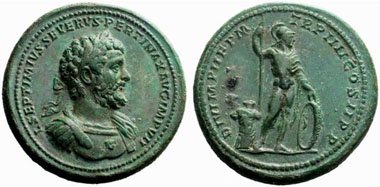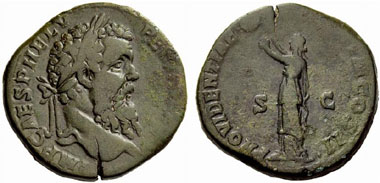Giovanni da Cavino was born in 1500 in the city of Padua. Padua is not far from Venice and was politically ruled by that more powerful metropolis. The city, however, had its own history as centre of arts where Giotto had worked and Donatello had created the first life-size equestrian statue of Modern Times.
The Condottiere Gattamelata, the first life-size equestrian statue of Modern Times created by Donatello.
Giovanni da Cavino belonged to that new generation of craftsmen that evolved into artists. He was the son of a goldsmith. Up to the death of his father he was trained by him, after that he became an apprentice of a master called Andrea Riccio. Cavino’s first work, mentioned in contemporary documents, was two silver candlesticks he delivered between 1527 and 1529 for the Padua Cathedral. The young man also devoted himself to the rising art of medal production. In 1554, Cavino made and signed a medal with the portrait of Pope Julius III, in 1565 two medals with the image of Christ. Amongst collectors of Roman coins, however, Cavino is famous for other products. Allegedly, he is one of the first coin forgers in history.
Medal by Giovanni da Cavino. Rev. Busts of Alexander Bassianus (in the front) and of Giovanni da Cavino (behind) r. NAC 53 (2009), 569.
Cavino’s products, called Paduans after his native city Padua, are copies of the finest Roman bronze coins and are traded for their own sake today amongst connoisseurs of the Renaissance art. He created them in cooperation with the humanist and coin collector Alessandro Bassiano. In the course of his career, Cavino copied more than 100 ancient coin types; he even invented further ones he thought the just developing academic discipline of archaeology had not discovered but were worth existing. Alessandro Bassiano was his congenial partner supplying the expertise whereas Cavino possessed the artisanship.
Coin invented by Cavino that pretends to be minted by C. Julius Caesar. From CNG 132 (2006), 286.
At the times, Bassiano belonged to a small group of numismatic authors: he had already written a book on the coinage of the 12 Caesars containing drawings of coins as well as explanations on their iconography and legends. Most possibly he advised his friend in inventing a bronze coin of C. Julius Caesar.
Imitation by Cavino of a sestertius of Septimius Severus. The depiction of Mars on its reverse is not comparable with a product of a Roman mint in regard to its perception of the body. From CNG 132 (2006), 306.
Cavino’s products are easily recognisable. Their weight alone is revealing. They are minted from much thinner planchets than the actual sestertii with depictions that are considerably more delicate.
Medallion of Septimius Severus with a depiction of Mars. From NAC 29 (2005), 569.
The artist was trained by Renaissance models with the bodies shown on his coins being very different from the ones we find on ancient coins. Cavino’s figures move naturally, their bodies are anatomically correct and far from appearing Roman.
Imitation by Cavino of a sestertius of Pertinax.
Cavino was least successful in imitating the Roman writing. Compared with an original sestertius of Pertinax, on the imitation by Cavino the lines of the writing appear boringly uniform.
Model for Cavino’s imitation: sestertius of Pertinax. From NAC 54 (2010), 1197.
The recesses at the letters’ beginnings and the varying depth of the die cut have become flattened and uniform. If there are still any doubts, it helps to have a look at the books devoted to the work of the Renaissance artist. They contain a most possibly complete catalogue – made with the help of the dies stored in the Bibliothèque nationale, Paris – of Cavino’s imitations (Z. H. Klawans, Imitations and Inventions of Roman Coins, 1977, with comprehensive bibliography).
Was Cavino a brilliant forger that supplied the just developing market for ancient coins? Or was he rather a craftsman that – in cooperation with the best numismatist of Padua – made copies of the coins the market could not provide to be present in every collection? To answer that question, it may help to collect some information on Cavino’s reputation. Actually, he had quite a good one. He was even appointed expert witness when two goldsmiths met in court in 1542. He would not have been entrusted with such a responsible had he be a person of dubious character. Apart from that, we know that from time to time Cavino combined the reverses of his imitations not only with the portraits of Roman emperors but with the recently made portraits of influential politicians and merchants of his native city as well. That would have been silly if his imitations really had tried to deceive collectors. The last proof of Cavino being honourably is the fact the there is a number of contemporaries that praise Cavino for his imitations. The first seems to have been a colleague. Enea Vico wrote in 1555 a study on Roman coins and mentioned Cavino as imitator (not as forger!). In 1560, Francesco Savonarola even praised both “fathers” of the Paduans, Cavino and Bassiano, in a verse: Your lives, o Ceasars, will shine forever by their (= Cavino’s and Bassiano’s, authors’ note) numismatic art.
Whoever calls Cavino a forger does him an injustice. He supplied a Renaissance want. The 16th century collector was not looking for what we today call authenticity. To him, the motive was important. Genuineness was of less relevance. Hence the lengthy galleries of “fake“ and real emperors’ portraits in contemporary Halls of Antiquities. They are not displayed separately but provide a tangled picture puzzle of genuine and fake. The only important thing was to cite antiquity – whether with a piece that really had come down from Antiquity or with a piece a modern artist created in the ancient spirit.
For more information on this subject please have a look at a monograph by Richard Hoe Lawrence from 1883 on the internet. Click here.





